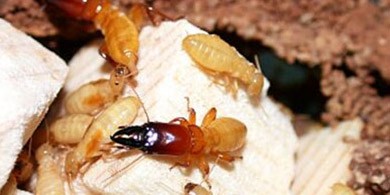
Tracking colony-building insects
Scientists have long been doing research into how the complicated system of living together in insect colonies functions. Researchers are also looking for answers in animals' DNA. A large international group of researchers – including scientists from Münster University – have now sequenced and analysed the genome of one termite species. This means that they have now been able to compare the termites' DNA with that of ants and colony-building bees. This is of particular interest to the researchers because although termites have a similar lifestyle – they, too, form colonies and have various castes such as workers and reproductives – they are not closely related to hymenopterans, which include bees and ants. The study has been published in the latest issue of the online journal "Nature Communications".
"The analysis of the termite genome is crucial in improving our understanding of decisive steps in the evolution of insects – the development of social insects," says Dr. Nicolas Terrapon, who carried out the study, as one of its main authors, during the time he spent as a post-doc at the Institute of Evolution and Biodiversity at Münster University. "Termites", he adds, "are, in contrast to bees and ants, quite original insects and belong to the cockroaches. Our investigations will help in acquiring a better understanding of the evolution of insects in general."
The scientists examined whether the evolution of sociality in various groups of insects was based on the same molecular mechanisms. In doing so, they discovered not only differences, but also things they had in common. One conspicuous difference they came across was in groups of genes involved in the maturing of the sperm in male animals. In the case of the species of termites that live in wood – Zootermopsis nevadensis (dampwood termites) – some of these genes occur more actively or in greater numbers than in the species of ants and bees hitherto examined. The researchers assume that this reflects a special feature of their lifestyle – that while male ants and bees, for example, produce a large number of sperm just once and then die shortly after mating, male termites mate with the queen of their nest several times during their life.
Another difference is that, in comparison with the highly social hymenopterans, the dampwood termites have only a few olfactory receptors. In general, smell plays an extremely important role for social insects, not only in communication and in recognizing nest comrades, but also in looking for food. Dampwood termites, however, have a simpler lifestyle than ants, honey bees or more highly developed termites. In looking for food, for example, they do not move away from the nest and display less complex communicative behaviour. The lower number of olfactory receptors reflects this lifestyle.
The researchers did, however, also discover things they have in common. Dampwood termites, for example, have – just like ants – an especially large number of genes which play a role in immune responses. Social insects are more dependent on effective infection controls, as pathogens will otherwise spread easily in the densely populated colonies. Moreover, the scientists have found proteins which might play an important role in the development of caste-specific features – just like a similar system in honey bees.
Prof. Erich Bornberg-Bauer (Münster University), Prof. Jürgen Liebig (Arizona State University, USA), Prof. Judith Korb (Freiburg University) and Guojie Zhang (China National Genebank, BGI-Shenzen, China) were involved in the study as project leaders. Dr. Nicolas Terrapon is now engaged on research at Aix-Marseille University in France.
Original publication:
Terrapon N. et al. (2014): "Molecular traces of alternative social organization in a termite genome". Nature Communications 5, Article number: 3636, doi:10.1038/ncomms4636
